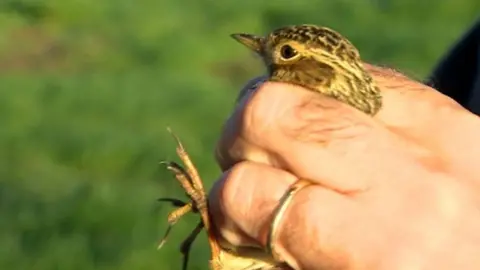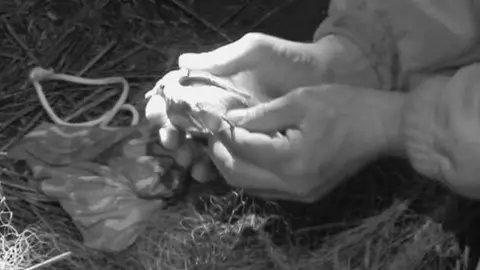A stunning skylark breakthrough begins in the Midlands
 BBC
BBCI had never actually seen a skylark up close.
Walking through stubbly fields, I have caught a glimpse of one or two out of the corner of my eye as they flash up into the sky. And of course I have seen them as small dots high in the air while they belt out their beautiful song. But I have never seen one up close let alone held one... until now.
In my hand it is a light little thing, around 35 grams, and I can feel the rapid patter of its heart.
It may be a small brown bird but they are very beautiful, with a tuft of feathers on the head and large brown eyes. I am astonished to see they also have an extremely long, backwards-facing, claw on each foot. In this case, 15mm long, although they can be much longer.
The bird I am holding has been ringed by Colin McShane from the Brewood ringers group in South Staffordshire. In a 40-year career, Colin has ringed maybe four skylarks, which gives you some idea of how unusual my close encounter really is.
Thermal imaging
But the Brewood group is leading the way with a new approach to catching and ringing skylarks. It has been using a thermal imaging camera to track down and trap the birds at night - and the result is they have gone from ringing the odd skylark every decade to hundreds over the course of a few months.
Traditional methods for catching birds do not really work on skylarks. To carry out standard bird surveys you usually set up mist nets. These are very fine nets that you put up around hedges and woods and then wait for birds to fly into them. They can then be retrieved and ringed.
But because skylarks live in the middle of fields, there is no point mist-netting because the nets would be very obvious and the birds just avoid them. All this means they are rarely caught and rarely ringed.
The lack of ringing is serious because it means we know surprisingly little about our skylarks. For example, do they move between this country and other parts of Europe?
We also lack much of the extra data ringers collect when they are in action. We are missing information on weights, sizes, even the length of that large claw on the skylark's foot.

The thermal camera has changed all this. It was purchased by The West Midland Bird Club and the Brewood ringers have been using it on three farms around Penkridge.
The team goes out at night and uses the camera to find the skylarks roosting on the ground, typically in stubbly fields. They show up as bright little spots on the cold black ground through the camera's viewfinder.
Dazzle
The team then creeps up on the bird, uses an ordinary torch to dazzle it and then catches it in a large, handheld net. The skylark is then ringed and released none the worse for its experience and all handling is done under licence. The end result is an extraordinary number of skylarks ringed in this part of the Midlands, easily twice the number ringed nationally.
It is safe to say all this will revolutionise what we know about skylarks, especially if more groups borrow this camera or even buy their own.
And this is not just information that is of interest to birders and wildlife nerds like me. For the farmer whose land we are working on, it is a chance to quantify and to see the impact of his approach to farming on local wildlife.
Ray Bowers of Lower Drayton Farm tends to avoid traditional ploughing. Instead he uses a much less invasive form of tilling. Might that be one reason skylarks, and many other birds, love his fields? As the government sets about creating a new agricultural policy for life outside the EU, is Ray's approach one the government and the rest of us want to encourage?
So this research will reveal much we did not know and could even shape the very look of the countryside. And having finally seen one of these beautiful birds up close, I opened my hand and let it go. Its long warbling song ringing out across the fields as it climbed into the sky.
